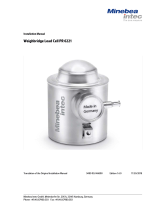Detecto FH Series is a versatile and reliable floor scale designed to meet the demands of various weighing applications. Its low-profile design allows for easy loading and unloading, while the sturdy construction ensures accurate and consistent measurements. With its multiple connectivity options, the FH Series can be integrated into various systems for data collection and management. It's ideal for industrial, commercial, and retail settings, providing precise weighing solutions for a wide range of materials and products.
Detecto FH Series is a versatile and reliable floor scale designed to meet the demands of various weighing applications. Its low-profile design allows for easy loading and unloading, while the sturdy construction ensures accurate and consistent measurements. With its multiple connectivity options, the FH Series can be integrated into various systems for data collection and management. It's ideal for industrial, commercial, and retail settings, providing precise weighing solutions for a wide range of materials and products.










-
 1
1
-
 2
2
-
 3
3
-
 4
4
-
 5
5
-
 6
6
-
 7
7
-
 8
8
-
 9
9
-
 10
10
Detecto FH Series is a versatile and reliable floor scale designed to meet the demands of various weighing applications. Its low-profile design allows for easy loading and unloading, while the sturdy construction ensures accurate and consistent measurements. With its multiple connectivity options, the FH Series can be integrated into various systems for data collection and management. It's ideal for industrial, commercial, and retail settings, providing precise weighing solutions for a wide range of materials and products.
Ask a question and I''ll find the answer in the document
Finding information in a document is now easier with AI
Related papers
-
Detecto 760PS Series Owner's manual
-
Detecto ARMOR Portable Digital Truck Scale Installation guide
-
Detecto ARMOR Digital Truck Scale Installation guide
-
Detecto 8500-8550 Service User manual
-
Detecto FHN Series Owner's manual
-
Detecto 7550 Wheelchair Scale with Wi-Fi/BLE Owner's manual
-
Detecto 225-iCAN User manual
-
Detecto DC Series Load Cell Kit User manual
-
Detecto 825-iCAN User manual
-
Detecto 7550 Wheelchair Scale with Wi-Fi/BLE Owner's manual
Other documents
-
Cardinal Detecto 6855 Operating Instructions Manual
-
Milltronics MMI-2 User manual
-
 Minebea Intec PR 6221/12.5 t Installation guide
Minebea Intec PR 6221/12.5 t Installation guide
-
Mettler Toledo 7461 Installation guide
-
Cardinal 2240 Operating instructions
-
Cardinal Detecto Specification
-
Mettler Toledo 7562 Portable Installation guide
-
Mettler Toledo 7560 Installation guide
-
Mettler Toledo Ultramount 0972 User manual
-
Welch Allyn 6702W Series User manual










